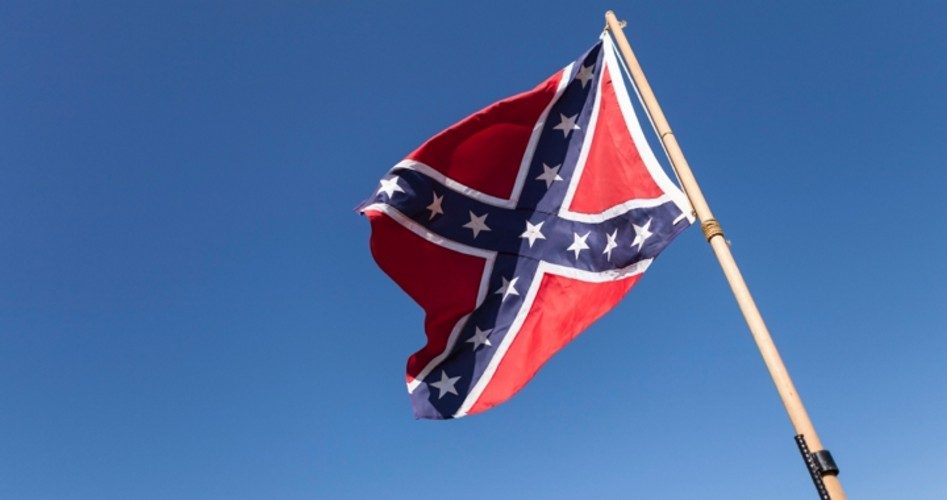
In an apparent attempt to avoid a confrontation with President Donald Trump, or lawsuits in court, Defense Secretary Mark Esper announced a new order that effectively bans the Confederate “battle flag,” without specifically naming it, but leaves — at least for now — the issue of military posts named after Confederate generals alone.
Trump, who is constitutionally the commander-in-chief of all military forces of the United States, has said publicly that he opposes changing the names of any of the several military installations in the South named for Confederate generals, and he could have simply vetoed any policy by Esper that did so. Probably because of that fact, Esper left the issue of the names of Confederate posts alone, and instead issued a policy dealing with the controversy over the display of what has been dubbed the Confederate “battle flag.”
The policy avoids specifically naming the battle flag — sometimes known as “the Southern Cross” — by instead listing a number of flags that are allowed on posts and bases. Esper evidently hoped this would make the issue less political, and avoid any legal challenge on free speech grounds. Esper did say that unauthorized flags, such as the Confederate flag often used during battles of the Civil War, is still acceptable in places such as museums, educational programs, and historical exhibits.
“Today I issued a memorandum to the force on the display of flags at @DeptofDefense facilities,” Esper tweeted. “With this change in policy, we will further improve the morale, cohesion, and readiness of the force in defense of our great nation.”
Previously, General David Berger, the commandant of the Marine Corps, ordered an end to public displays of the Confederate battle flag at his installations, arguing, “The Confederate battle flag has all too often been co-opted by violent extremist and racist groups whose divisive beliefs have no place in our Corps.” He noted that the flag was used by extremist groups during violent confrontations in Charlottesville in 2017, which highlights “the divisiveness the use of the Confederate battle flag has had on our society.” He went on to assert that that its display “presents a threat to our core values, unit cohesion, security, and good order and discipline.”
While one can understand General Berger’s concern about a flag, or anything else, causing divisiveness — as it has been co-opted by “violent extremist and racist groups,” so has the flag of the United States, and even the Christian cross. After all, one would not expect the banning of either just because those symbols have been misused by some? It is well established that, for example, meetings of the Ku Klux Klan exhibit the flag of the United States much more often than the Confederate battle flag. And the burning of crosses is a well-known tactic of such groups, to show displeasure at some person or group.
One would hope that Esper and the top brass of the armed forces would swiftly remove other flags that are controversial, such as the hammer and sickle flag (communist), or flags of Antifa, and Black Lives Matter.
Flags listed as acceptable include any U.S. or state flag, flags of other allies or partners, the POW/MIA flag and other official military unit flags. Unfortunately, this could mean that the flag of the United Nations could be displayed, if someone was so inclined to fly it.
The “battle flag” was never an official flag of the Confederacy, but was often used in battle — thus its popular name — to clearly distinguish it from the U.S. flag. During the Battle of Bull Run (or Manassas, as the Confederates who won that battle, called it), the Confederate “Stars and Bars” with three strips was hardly distinguishable from the Union “Stars and Stripes” through all the gun smoke and dust stirred up during the battle. That is why the “battle flag” came to be used more and more as the war dragged on. Many southerners were of Scottish ancestry, and the battle flag was quite similar to the flag of Scotland.
After the Civil War, in an effort to reconcile the South to the Union, it was decided to name military posts in the South after Confederate generals, such as Robert E. Lee, Braxton Bragg, and John Bell Hood. Today, reconciliation is apparently no longer considered a virtue by those who wish to rename the posts. Some have even suggested renaming Fort Bragg after former President Barack Obama — who never served in the military. That, of course, would be anything but conciliatory.
For now, and as long as Trump is president, the names of the southern military posts will remain as they are. But were former Vice President Joe Biden to win the presidency in November, it is likely that the names of those posts will fall — perhaps with one being dubbed Fort Obama.
Photo: NeilLockhart/iStock/Getty Images Plus
Steve Byas is a university instructor of history and government, and the author of History’s Greatest Libels. He may be contacted at [email protected].

